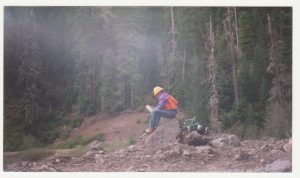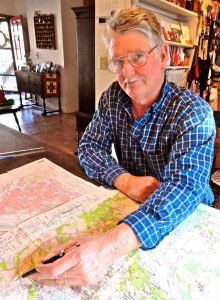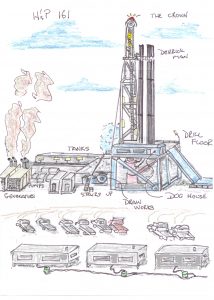John Rehm – 1973

John Rehm on Resting on Landslide Deposits
Geology was a great fit for me because I loved the outdoors. I hated being inside. Even now, I have to get out and take a drive, look at rocks or visually gage a stream. My career in geology started as a boy running through the fields of straw and stunted native juniper trees in my hometown, Basking Ridge, NJ. This was before the town was as built up as it is. Four years in Boy Scouts led me to mapping and to team work. I knew that the steep hill that we tobogganed down (we crashed and blacked out, and then went home to tell our tale) was a terminal moraine.
When I got to Lafayette, I was an Economics major, but although Macroeconomics was fascinating, I could not see myself, inside again, practicing “the Dismal Science”, so I took Geology in my second year. The big moment of commitment came during a field trip,looking down at Professor Faas, who was gesturing broadly in the bottom of a glacial outwash basin, pleading for our understanding. I practically grabbed him by the collar in his office that night, and said, “Doctor Faas, you will make me a Geologist”. He said, “John, you won’t make much money.” I said, “I don’t care” and repeated my demand.

John doing office map work

One of John’s field sketches of a Louisiana Oil Rig
At Gulf, I learned that geologic formations can be charted electrically and geophysically. The company research at that time evaluated interstitial voids, and called the doorways between them, “pore throats”. Geophysical and Optical Microscope measures (where is my point-counter?) can be compared to pressure and flow tests and ultimately to well production, be it as groundwater or energy products (shale gas, natural gas, condensate or oil, tar oil).

John on a four wheeler at a Oregon Nursery, getting ready to go measure wells
I am still having fun in my field. Some of my recent consulting has revisited study areas where I worked for the Oregon Water Resources Department, thirty years ago, right down to an aquifer test that I did in 1986. With the experience that I have gained in the rocks within 20 miles around my home in Salem, Oregon, I was able to figure out why that aquifer test did not demonstrate any interference in the observation wells. I have a big hearing coming up on a hilltop residential area and will be running more tests with my 2nd son. Life is rich.